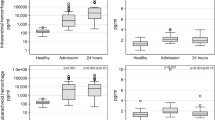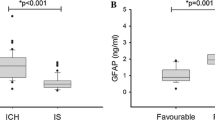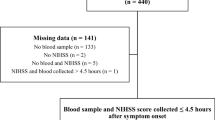Abstract
Serum glial fibrillary acidic protein (GFAP) has been reported to have high diagnosis accuracy for differentiating intracerebral hemorrhage (ICH) from ischemic stroke (IS) in patients within acute phase of stroke symptom onset. Our purpose was to perform a systematic review and diagnostic meta-analysis to evaluate the valuation of serum GFAP in the early identification of ICH and IS. We searched MEDLINE, EMBASE and other electronic databases for diagnostic accuracy studies that compared serum GFAP with standard clinical diagnosis of ICH and IS in patients with symptoms of acute stroke. All publication years were included through to April 2013. The sensitivity (SEN), specificity (SPE), and positive and negative likelihood ratios (PLR and NLR, respectively) of serum GFAP for differentiating ICH and IS were pooled using a bivariate meta-analysis. Summary receiver operating characteristic curves were used to summarize overall test performance. A total of five trials met our inclusion criteria. The summarized estimates of serum GFAP for the differentiation of ICH and IS within 24 h of symptom onset were as follows: SEN, 81.1 % (95 % CI, 72.6–87.5 %); SPE, 95.2 % (95 % CI 82.1–98.9 %); PLR, 16.945 (95 % CI 4.173–68.803); NLR, 0.198 (95 % CI 0.133–0.296), significant heterogeneity was present. The four summary estimates of serum GFAP for patients within 1–6 h of symptom onset were 81.1 % (95 % CI 72.5–88.0 %), 97.0 % (95 % CI 94.3–98.4 %), 26.786 (95 % CI 13.979–51.324), 0.191 (95 % CI 0.126–0.291), respectively, with no obvious heterogeneity. Serum GFAP is a sensitive and specific test for differentiating ICH and IS in patients within 1–6 h of acute stroke symptom onset.




Similar content being viewed by others
References
Cheung RT (2007) Update on medical and surgical management of intracerebral hemorrhage. Rev Recent Clin Trials 2(3):174–181
Adams HP Jr, del Zoppo G, Alberts MJ, Bhatt DL, Brass L, Furlan A, Grubb RL, Higashida RT, Jauch EC, Kidwell C, Lyden PD, Morgenstern LB, Qureshi AI, Rosenwasser RH, Scott PA, Wijdicks EF, American Heart A, American Stroke Association Stroke C, Clinical Cardiology C, Cardiovascular R, Intervention C, Atherosclerotic Peripheral Vascular D, Quality of Care Outcomes in Research Interdisciplinary Working G (2007) Guidelines for the early management of adults with ischemic stroke: a guideline from the American Heart Association/American Stroke Association Stroke Council, Clinical Cardiology Council, Cardiovascular Radiology and Intervention Council, and the Atherosclerotic Peripheral Vascular Disease and Quality of Care Outcomes in Research Interdisciplinary Working Groups: the American Academy of Neurology affirms the value of this guideline as an educational tool for neurologists. Stroke: J Cereb Circ 38(5):1655–1711. doi:10.1161/STROKEAHA.107.181486
Eng LF, Ghirnikar RS, Lee YL (2000) Glial fibrillary acidic protein: gFAP-thirty-one years (1969–2000). Neurochem Res 25(9–10):1439–1451
Missler U, Wiesmann M, Wittmann G, Magerkurth O, Hagenstrom H (1999) Measurement of glial fibrillary acidic protein in human blood: analytical method and preliminary clinical results. Clin Chem 45(1):138–141
Foerch C, Curdt I, Yan B, Dvorak F, Hermans M, Berkefeld J, Raabe A, Neumann-Haefelin T, Steinmetz H, Sitzer M (2006) Serum glial fibrillary acidic protein as a biomarker for intracerebral haemorrhage in patients with acute stroke. J Neurol Neurosurg Psychiatry 77(2):181–184. doi:10.1136/jnnp.2005.074823
Unden J, Strandberg K, Malm J, Campbell E, Rosengren L, Stenflo J, Norrving B, Romner B, Lindgren A, Andsberg G (2009) Explorative investigation of biomarkers of brain damage and coagulation system activation in clinical stroke differentiation. J Neurol 256(1):72–77. doi:10.1007/s00415-009-0054-8
Dvorak F, Haberer I, Sitzer M, Foerch C (2009) Characterisation of the diagnostic window of serum glial fibrillary acidic protein for the differentiation of intracerebral haemorrhage and ischaemic stroke. Cerebrovasc Dis 27(1):37–41. doi:10.1159/000172632
Foerch C, Niessner M, Back T, Bauerle M, De Marchis GM, Ferbert A, Grehl H, Hamann GF, Jacobs A, Kastrup A, Klimpe S, Palm F, Thomalla G, Worthmann H, Sitzer M, Group BFS (2012) Diagnostic accuracy of plasma glial fibrillary acidic protein for differentiating intracerebral hemorrhage and cerebral ischemia in patients with symptoms of acute stroke. Clin Chem 58(1):237–245. doi:10.1373/clinchem.2011.172676
Whiting P, Rutjes AW, Reitsma JB, Bossuyt PM, Kleijnen J (2003) The development of QUADAS: a tool for the quality assessment of studies of diagnostic accuracy included in systematic reviews. BMC Med Res Methodol 3:25. doi:10.1186/1471-2288-3-25
Wunderlich MT, Wallesch CW, Goertler M (2006) Release of glial fibrillary acidic protein is related to the neurovascular status in acute ischemic stroke. Eur J Neurol 13(10):1118–1123. doi:10.1111/j.1468-1331.2006.01435.x (The official journal of the European Federation of Neurological Societies)
Jaeschke R, Guyatt GH, Sackett DL (1994) Users’ guides to the medical literature. III. How to use an article about a diagnostic test. B. What are the results and will they help me in caring for my patients? The Evidence-Based Medicine Working Group. JAMA 271(9):703–707
Hergenroeder GW, Redell JB, Moore AN, Dash PK (2008) Biomarkers in the clinical diagnosis and management of traumatic brain injury. Mol Diagn Ther 12(6):345–358. doi:10.2165/1250444-200812060-00002
Vissers JL, Mersch ME, Rosmalen CF, van Heumen MJ, van Geel WJ, Lamers KJ, Rosmalen FM, Swinkels LM, Thomsen J, Herrmann M (2006) Rapid immunoassay for the determination of glial fibrillary acidic protein (GFAP) in serum. Clin Chim Acta: Int J Clin Chem 366(1–2):336–340. doi:10.1016/j.cca.2005.11.017
Berger RP (2006) The use of serum biomarkers to predict outcome after traumatic brain injury in adults and children. J Head Trauma Rehabil 21(4):315–333
McComb RD, Burger PC (1985) Pathologic analysis of primary brain tumors. Neurol Clin 3(4):711–728
El-Jawahri A, Patel D, Zhang M, Mladkova N, Chakravarti A (2008) Biomarkers of clinical responsiveness in brain tumor patients: progress and potential. Mol Diagn Ther 12(4):199–208
Nylen K, Csajbok LZ, Ost M, Rashid A, Blennow K, Nellgard B, Rosengren L (2007) Serum glial fibrillary acidic protein is related to focal brain injury and outcome after aneurysmal subarachnoid hemorrhage. Stroke: J Cereb Circ 38(5):1489–1494. doi:10.1161/STROKEAHA.106.478362
Herrmann M, Vos P, Wunderlich MT, de Bruijn CH, Lamers KJ (2000) Release of glial tissue-specific proteins after acute stroke: a comparative analysis of serum concentrations of protein S-100B and glial fibrillary acidic protein. Stroke: J Cerebral Circ 31(11):2670–2677
Mondello S, Jeromin A, Streeter J, Gabrielli A, Schmid K, Tortella F, Hayes RL, Wang KK (2011) Glial fibrillary acidic protein, a sensitive and specific marker in serum for the identification of intracerebral hemorrhage in acute stroke patients: results of improved assay performance. Circulation 124:21(Suppl 1)
Conflict of interest
None.
Author information
Authors and Affiliations
Corresponding author
Rights and permissions
About this article
Cite this article
Zhang, J., Zhang, CH., Lin, XL. et al. Serum glial fibrillary acidic protein as a biomarker for differentiating intracerebral hemorrhage and ischemic stroke in patients with symptoms of acute stroke: a systematic review and meta-analysis. Neurol Sci 34, 1887–1892 (2013). https://doi.org/10.1007/s10072-013-1541-3
Received:
Accepted:
Published:
Issue Date:
DOI: https://doi.org/10.1007/s10072-013-1541-3




